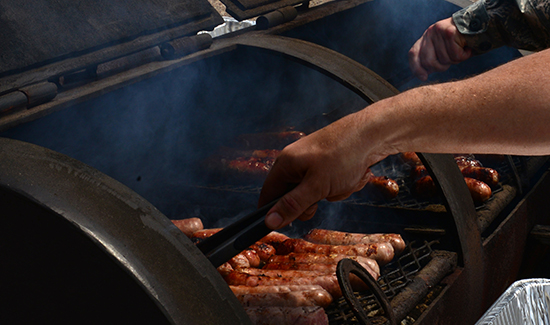Reach events are the best way to connect with new people
by Don Corder
In order to grow, one thing has to happen: The church has to interact with more people. Then we need to connect with those people by capturing their contact info and then reaching out to them.
The order of discipleship in today’s world is: Connect, Evangelize, Convert. In most cases, the neighborhood is not going to be evangelized until they’ve first connected. To fulfill the mission to make disciples, people are the “raw material” needed. No people, no disciples. When you’re on a limited budget or have few resources, then for the time and money invested, you want to make as many connections with as many people as possible.
In order to analyze the ability to make connections, one of the first questions I ask a church I’m serving is, “How many names are on your database?” This is not a membership or money question. It’s an evangelism question. The answer indicates how engaged the church is with the community and neighborhood. If a church that gets 200 for worship has 400 names on the database, it’s not doing much to engage the neighborhood.
Generally speaking, a church needs about two to three times as many names on their database as they get in worship just to support worship attendance. Why? Because, statistically speaking, for every unique individual who visits your church more than once a month, about 3.43 unique individuals attend less than once a month. If that same church with 200 in worship was doing a decent job of evangelizing the neighborhood and creating community, I would expect them to have 1,000 - 1,200 names on their database. The database represents real people. Connecting with those people is how churches grow.
Let me give you three steps to extending yourself into the community—whether or not you have any budget:
STEP ONE: Hold a Reach Event
To grow your people connections, you have to capture names from the neighborhood, meaning the people all around you for whom you have no contact information. To “reach” the neighborhood you have to invite the neighborhood to “come” and “connect” by using media such as signs, door hangers, advertisements, social media, target marketing or knocking on doors. To invite the neighborhood, you have to have something to invite them to. I call what you invite them to “reach events.” What makes a “reach event” unique is using media to reach people for whom you have no contact info. I recommend reach events be non-religious—and involve food. Non-religious because we want people who live far from Jesus to come. Food because everyone eats and likes good food.
How much you spend on your “party” or “reach event” depends on your budget. If your church has a large outreach budget, you can do just about anything: a chili cook-off, a carnival, a car show. Let’s say the church has no money and no young people. That church can have a Parent’s Day Out or Date Night and let the young parents in the neighborhood drop off their children for a couple of hours with kindly grandparents at the church to watch them. Or, you can show the movie Dumbo or Cinderella in the sanctuary for the kids and grill some burgers in the parking lot, so the young parents can sit around, drink sweet tea, relax, and meet each other.
One of my favorite neighborhood reach events for a church on a tight budget is a food truck festival. You invite a conglomeration of food trucks to your parking lot and let them set up shop. Food truck festivals are fun for the whole family and appeal to a wide spectrum of people. Even better, food trucks will partially pay you back a percent of their revenue for the day. Many of them won’t end up paying you the full amount owed, so you have to go into it with your eyes open. But because you get some return income, a food truck festival is less expensive than other kinds of parties. Your expenses will involve a generator, some porta-potties, whatever name-capture materials you may need, and some advertising. (The Provisum Group can help you get door hangers to canvas the neighborhood for a few pennies per household.)
STEP TWO: Ask Your Neighbors for Their Contact Information
Your reach event needs to be FREE to the neighborhood, but you want to capture names. To do that for large events like a car show, we suggest you place orange vinyl construction fencing around the entire party and create “choke points” — openings in the fence that people will funnel through. Make as many entrances as you can adequately staff for the entire day, so the neighborhood doesn’t get discouraged by long lines or tempted to hop the fence. At the entrances, your smiling gatekeepers will offer a paper wristband to attendees once they have texted a number you’ve set up ahead of time, or written down their e-mail address or signed up on the church app. I’ve seen a food truck festival result in as many as 3,000 new names in a day.
STEP THREE: Contact Them
In the first thirty-six hours after your reach event, you can expect thirty to forty percent of the people whose names you collected to unsubscribe or bounce (fake e-mail addresses). But sixty to seventy percent won’t. That group is your target for follow-up. Remember what happened on the Day of Pentecost. We are making a crowd out of a crowd (Acts 2). Make sure you have a prerecorded video ready to go thanking them for coming to your event and inviting them to the next worship service or at least an email, text, or message from your church app. Also, make sure you have a group of volunteers standing by to input all the new contact info you collected into your database and/or your e-mail platform. Then start sending them your weekly e-newsletter.
Case Study of a Dying Church That Held a Reach Event
How this works in real life is best illustrated by a wonderful story that happened to a dying suburban church. Back in the 1950s and 60s, this neighborhood church grew to about 400-500 in worship. That was a huge church in those days. When I was called in a few years ago, which was more than forty years after their peak, the church was down to about sixty people in worship, mostly seniors, and the church was broke. They didn’t have a website or social media. They didn’t even have a spreadsheet with members’ names. Nothing had changed year after year except for when a parishioner died. Over the years, their predominantly white middle-class neighborhood had become an ethnically mixed, working-class neighborhood of young families of a different race. The church had never adjusted to the times. Now they had a huge gap generationally, racially, and culturally with their neighborhood.
The pastor wanted to know what to do, so I told him to go out and find $500. He couldn’t imagine how he could find $500 from his members. I advised him, “You cannot be certain that there are not ten saints who have been praying for revival in this church for the last thirty years. Find them and ask them for the money.” He did. They gave. With the money, we had a huge vinyl sign made very inexpensively, white with big dark blue letters that spelled out “FREE COOKOUT THIS FRIDAY.” The church was geographically situated so everyone in the neighborhood had to pass by the church to get in and out of the neighborhood. We moved the sign around for a week to face different directions in order to ensure everyone saw it.
That Friday, the church brought in someone’s grill, got some hamburgers and hot dogs, and had ten of the saints on hand just to love the people who came. The first night, fifteen people showed up for free food, mostly young parents and some kids. Seeing who he’d attracted, the pastor asked for another $500 to purchase basketball hoops. When he got to church on the following Sunday, someone had already put up the hoops in the parking lot. The church kept advertising their free food nights and started a three-on-three pick-up basketball tournament. It grew. Today, every Wednesday night the church has 80 to 100 people come for a free meal, basketball (weather permitting), and a short Bible study.
Next, we helped with their website, name capture and e-welcome series. An e-welcome series (sometimes called a “drip campaign”) is three to five pre-produced e-mails, with video if you can do it, thanking people for coming and highlighting the ministry's best attributes.
Today, that church has a spreadsheet with about 1,000 names. But that’s not all they have. One Sunday, a check for $15,000 landed in the offering plate. In the notes section on the check were two words: “Well done!” They hadn’t had air conditioning in fifteen years, but they were able to get it working. Then another big check landed in the offering plate. They opened an area of the church that had once been used for children’s ministry but had been locked and chained off because of mold—and no need for it since no one with children attended. They got a work crew after it with bleach and paint. Suddenly young families started showing up on Sundays. The next Easter, they had a neighborhood Easter egg hunt with over 500 kids participating. Today they have two weekly worship services and a Wednesday night fellowship and Bible study. They’re still growing, and they’ve also managed to put $100,000 in the bank. Their average attendance on Sunday mornings is 150 people of all backgrounds and ages.
A final note about free food: One church we serve is a fast-growing urban congregation. They shut down their free food pantry because they realized it communicated the opposite of what the church stood for. What the church thought it was saying was, “We care about you.” But what the neighborhood was hearing was, “You think I’m poor because I’m _______.” (You can fill in the blank with anything.) The food bank in the recipients' minds underscored their perceived lot in life. Instead, the church started a community meal once a week. It took off. The message the church now sends is, “We care about you so much that we want to invite you over for dinner and get to know you.” And by the way, they are fast-growing because they are stringent about capturing names and follow-up.
Remember, to grow your church you have to meet new people and invite them to come. Then you need to get them to connect. Reach events are the best way to do both. CGM






